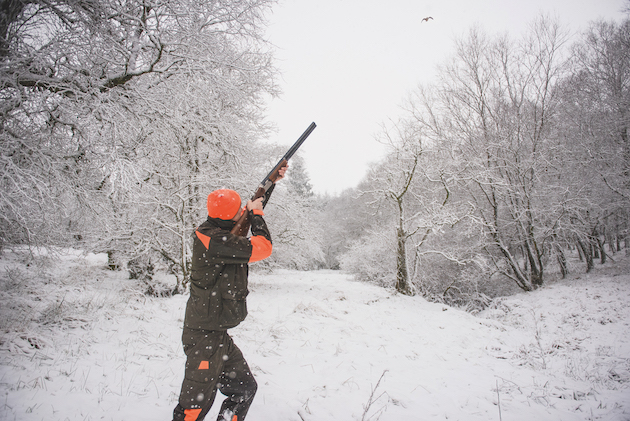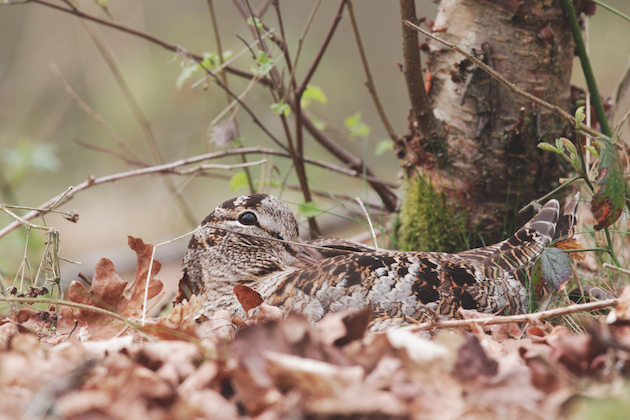Win CENS ProFlex DX5 earplugs worth £1,149 – enter here
How we can help nurture our wonderful woodcock
 An open clearing chanels a woodcock toward Patrick Galbraith, the visibility is good but the fast, darting flight of the Woodcock makes the bird a challenge to hit and it passes the line of guns and is away
Usd SG jan 20 games
An open clearing chanels a woodcock toward Patrick Galbraith, the visibility is good but the fast, darting flight of the Woodcock makes the bird a challenge to hit and it passes the line of guns and is away
Usd SG jan 20 games
Woodcock have a reputation of being unpredictable in their movements, here today and gone tomorrow. So you could be forgiven for feeling that whether or not you shoot them makes little difference to numbers in the long-term.
To the Victorian sportsman, a ‘fall’ was not to be missed. If the keeper found some, he would rush to tell the boss and invitations to woodcock shooting tomorrow would be sent out in a hurry. The first clues that this story of randomness might not be quite right came surprisingly early. I remember reading an account of an odd-coloured bird trapped by an early Victorian gamekeeper on the Gower Peninsula in South Wales and taken to his boss. In an early example of bird ringing, the boss put a band of metal around the bird’s leg and had it released where caught. It was shot in the same spot a year later. Bearing in mind that back then woodcock hardly bred in the UK, this was a first clue to the site fidelity of migrating birds that we have begun to understand in detail over the past two decades.
Population trends
Since those days, we have planted lots of woodland in the UK and it is perhaps unsurprising that the woodcock have responded. Everyone knows about the large-scale afforestation of the 20th century, but it is very likely that the early growth in the home-breeding population, which was documented by the Victorians, was helped by the planting of game coverts as pheasant shooting took off. So whatever you may have heard about woodcock declining should be set against this.
Our home-breeding population probably peaked in the 1970s, though even then they would have been scarce in the western extremities. The great woodcock shooting counties of Cornwall and Pembrokeshire probably never produced any home-bred birds. Back then, breeding woodcock were commonplace where I lived in Surrey, but I do not remember seeing a roding bird during my university years of 1974 to 1981 in the Swansea area, even though they were a common winter visitor. Even at their home-breeding peak, most of the woodcock that made their way into the sportsman’s bag were winter migrants and there is little indication to this day that wintering numbers are in decline or that shooting is having any harmful effect.
The GWCT’s National Gamebag Census shows wide annual fluctuations, with an increase of around 50% in the past five decades, though there is a small decrease over the past 10 years. This is an index of birds shot and may represent variations in the amount of shooting, rather than total numbers. In my favourite woodcock woods, I detect a small increase over the years.

Research shows that woodcock return to the same woodland each winter
Site-faithful
The fact that most of our woodcock are migrants does not mean that how many we see is a matter of chance. There is every reason to believe that how we treat our woodcock affects how many we will see in subsequent years and it is now clear from the science that they are very site-faithful. That early ringing return is confirmed by more sophisticated tracking systems. Woodcock fitted with satellite tags by GWCT researchers on their wintering grounds have a habit of turning up in the same wood, foraging for worms in the same field, each winter. They also tend to breed in the same places each summer, using the same staging posts en route. So leaving a good stock after the season makes huge sense.
Sending more birds back to the breeding grounds is surely likely to result in more birds in our coverts next winter. Hence the GWCT’s advice on woodcock shooting. Paraphrased, it says take a modest harvest, but please do not be greedy. Also, in case the decline in home-bred birds is exacerbated by shooting woodcock, wait until December when the migrants arrive in numbers before you shoot. That way, you should not subject home-bred birds to extra pressure by including them in the programme more often than migrants.
Also, if the weather goes cold and most of your woodcock move on, those that remain are likely to be home-bred, so restraint makes conservation sense.
Waiting for the woodcock flight
Woodcock moon
My colleagues can show clearly that woodcock migrate by day and night, and whether the moon be full or new, but I still believe in the romance of the woodcock moon. I am still convinced that I see an influx after each full moon from late October on.
Many driven shoots now say ‘no woodcock’ and I would rather this than have them on the list every Saturday. But how about having one day that is more about woodcock than pheasants? I ran across this concept on a Cornish estate a few years ago.
Boxing Day foray
With a dozen syndicate days and a similar number let, it would have been easy to overexploit them, so there was a ‘no woodcock’ rule. But not shooting any all season is a lost opportunity. The answer was to relax the rule on a Boxing Day foray for the syndicate, bringing in odd outside coverts not otherwise shot. The result was a brace or so for everyone to take home and a memorable day. In winter, woodcock do not actually do that much feeding in the woods. They mostly flight out to pastures and worm-rich fields under cover of darkness. In doing this, they often follow flightlines, with bird after bird on the same route. This can present a very exciting prospect, but also offers the chance to overshoot far too easily.
As a rule, do not expect to walk-up or drive the same woods as you shoot at flight. My choice is to only flight woods that are impossible to address any other way. Thicket-stage conifers are a prime example but, even then, only go once or at most twice a season.
When I was young, I got permission to try a third go on a very special flightline. I saw rather fewer birds then found that it was decidedly thin the following season.
Having a woodcock in the bag makes for a memorable shoot day
Woodcock woods
Many people think that there is precious little you can do to increase your woodcock, but this is not true. If you are reliant on migrants, a predation control programme that you would run for partridges is clearly no help. Woodcock nest on the ground and there is every reason to believe that a fox control programme will help home-breeders. Making your woods hospitable is significant, too. Woodcock like open canopies and scrubby undergrowth in summer and winter, so keeping your woods in good order will make a difference.
A local Forestry Commission wood has an acre patch of hazel that has been coppiced about once every 10 years for the past four decades. Each time, that patch has become a favourite place to find a woodcock for several seasons after being cut.
Woodcock are precious. I love the sport and a winter without a roast woodcock on a thick slice of buttery fried bread is unthinkable. But they are not an endless resource. We must treat them as very special, with respect and restraint. If we do, there is no reason not to take a modest harvest but please do not be greedy.
Related Articles
Get the latest news delivered direct to your door
Subscribe to Shooting Times & Country
Discover the ultimate companion for field sports enthusiasts with Shooting Times & Country Magazine, the UK’s leading weekly publication that has been at the forefront of shooting culture since 1882. Subscribers gain access to expert tips, comprehensive gear reviews, seasonal advice and a vibrant community of like-minded shooters.
Save on shop price when you subscribe with weekly issues featuring in-depth articles on gundog training, exclusive member offers and access to the digital back issue library. A Shooting Times & Country subscription is more than a magazine, don’t just read about the countryside; immerse yourself in its most authoritative and engaging publication.







